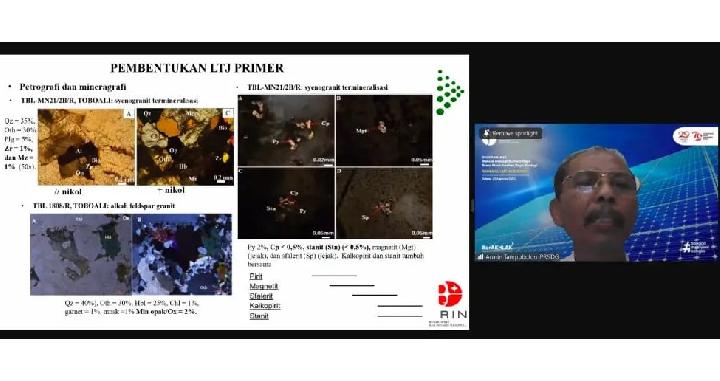News
BRIN Discovers Bangka Belitung Islands' Rare Earth Metals Potential
WINDONESIA September 5, 2024 Presentation on rare earth metals. (National Research and Innovation Agency)
Presentation on rare earth metals. (National Research and Innovation Agency)
National Research and Innovation Agency (BRIN)'s Geological Resources Research Center (PRSG) Lead Expert Engineer Armin Tampubolon stated that, although it has not been explored in detail until now, Bangka Island has great potential for primary rare earth metals, especially in granite that is widespread in the region.
The Bangka Belitung Islands Province, which are part of the Southeast Asian tin belt, have long been known as a region rich in tin minerals. In addition, the area also shows significant potential in terms of rare earth metal content.
Rare earth metals are a group of 17 elements that are very important in modern technology. In Indonesia, rare earth metals are often found as associated minerals in tin deposits, granitoid accessories, polymetallic veins, and the results of granitoid weathering.
"More than 20 locations in South Bangka [Regency] have been analyzed by the PRSG. The area is divided into several belts based on the dominant granite type, with the eastern belt dominated by type-I granite. The main belt covering Thailand, Malaysia, and Indonesia is dominated by type-S granite, and the western belt (Thailand-Burma) has type-S and type-I granite," Armin said in a written statement on Aug. 23, 2024.
Research on primary rare earth metal minerals was carried out using various analysis methods such as scanning electron microscopy and energy dispersive X-ray spectroscopy (SEM-EDS), electron probe micro-analyzer (EPMA), and backscattered electron (BSE).
One of the important findings in Toboali District, South Bangka Regency is the TBL-21MN/02B/R granite which contains various rare earth metal minerals, including allanite, parisit, bastnasite, and others. Indications of rare earth metals related to hydrothermal activity were also found in Air Gegas District, with quartz veins brecciated with biotite, monazite, and zircon in the contact zone.
Research in Toboali District also shows that granite containing quartz veins has a content of tin at 0.46 percent and rare earth metals in the form of xenotime. On the other hand, yttrium orthophosphate, a major component of xenotime, was not detected in the quartz veins, indicating that the final stage of hydrothermal did not carry yttrium. Statistical analysis showed no significant correlation between tin and rare earth metals, except for heavy rare earth metals.
Armin explained that the weathering profile of TBL-21KP/14/CS in Toboali District showed a gentle rare earth metal enrichment pattern, from heavy rare earth metals to light rare earth metals, with a sharp negative europium anomaly. The enrichment of rare earth metals resulting from weathering of the granite bedrock carrying primary rare earth metals occurred in horizons C and D, due to the adsorption mechanism of ion exchange clay.
"The absorbed rare earth metals come from the results of groundwater decomposition of rare earth metal minerals in the granite bedrock and rare earth metals resulting from oxidation that precipitate from the horizon above. The enrichment of light rare earth metals is higher than that of heavy rare earth metals," he explained.
Armin emphasized that the research is an important basis for the exploration of rare earth metal resources in Bangka Belitung Islands. The potential for rare earth metals is not only found in alluvial tin deposits, but also in granite weathering, especially in the contact area of the Pemali Complex and Kelabat Granite.
Rare earth metal enrichment in granite weathering, both clay and laterite dominant, has great potential considering the wide distribution of granite.
"We must study this potential more deeply to optimally utilize our natural resources," said Armin.

